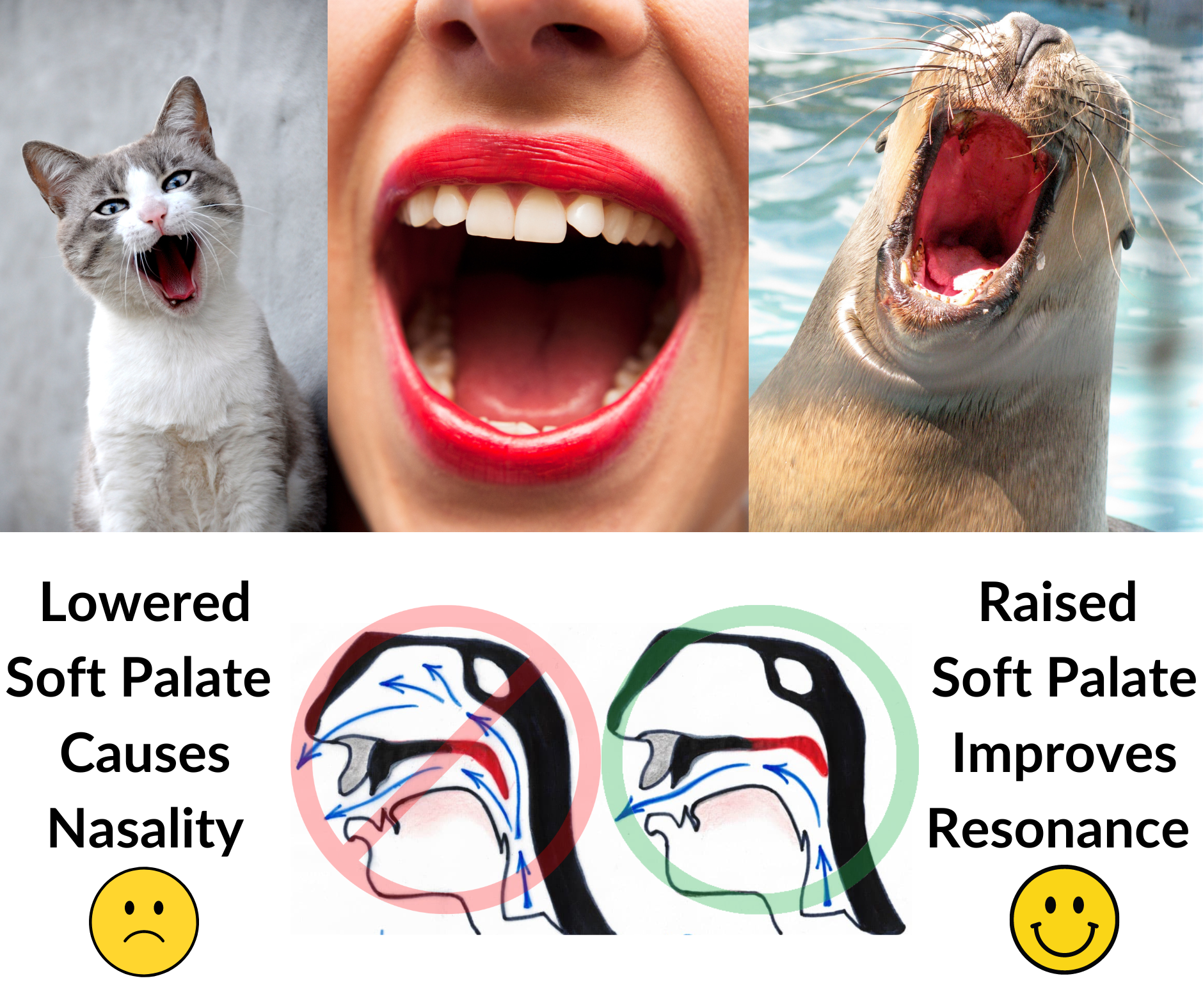Mastering the Raised Soft Palate: Your Key to Resonant Singing Without Nasality
Achieving a rich, resonant vocal tone is a goal for every singer, but nasality can easily get in the way. The culprit? A lowered soft palate. Understanding how to lift and control the soft palate is one of the most critical skills a singer can develop. In this post, we’ll explore the role of the soft palate in singing, clear up confusion about nasality vs. nasal resonance, and give you practical tips to eliminate nasality and unlock more vocal freedom.
What is the Soft Palate?
The soft palate (or velum) is the soft tissue located at the back of the roof of your mouth. Unlike the hard palate in the front, the soft palate is mobile, and its position determines whether airflow goes through the mouth or the nose.
When the soft palate is lifted, it blocks air from escaping through the nasal cavity, which is essential for singing clear, resonant vowels. When the soft palate is lowered, air flows into the nasal cavity, which can cause a nasal tone—an undesirable quality in most styles of singing.
Nasal Resonance vs. Nasality: What’s the Difference?
Many singers struggle to distinguish between nasal resonance and nasality, but it’s crucial to understand the difference:
- Nasal resonance refers to the natural vibration of sound waves in the bones and cavities of the face, including the nasal passages. Even when the soft palate is raised and airflow is directed through the mouth, sound waves can still resonate in the nasal cavities. This type of resonance helps give the voice brightness and clarity, especially in higher frequencies. Importantly, nasal resonance occurs without air escaping through the nose.
- Nasality, on the other hand, occurs when the soft palate is too low, allowing air to escape into the nasal cavity during non-nasal sounds. This results in a thin, nasal tone that lacks fullness. Nasality is useful for consonants like “m,” “n,” and “ng,” but it’s generally avoided on vowel sounds.
In summary: nasal resonance is beneficial, but nasality is not—except for nasal consonants.
Why Is a Raised Soft Palate So Important?
A raised soft palate is essential for achieving a well-rounded, resonant tone because it:
- Prevents nasality: By lifting the soft palate, you block air from flowing through the nasal cavity, preventing an overly nasal sound.
- Increases resonance: When the soft palate is raised, it creates more space in the vocal tract, allowing sound waves to resonate in the mouth and throat, resulting in a fuller tone.
- Enhances vocal control: A raised soft palate encourages a relaxed, open throat, which allows for greater vocal flexibility and freedom.
In English, we only need to lower the soft palate for the nasal consonants “m,” “n,” and “ng.” For all other sounds, especially vowels, the soft palate should be lifted to avoid nasality.
How to Check for Nasality
You can use a few simple techniques to check if nasality is creeping into your singing. These methods help you monitor how much air is escaping through your nose and how effectively your soft palate is lifting.
- Pinch Your Nose Test:
- Sing a sustained vowel while pinching your nostrils closed.
- If the sound changes or becomes muffled when you pinch your nose, it’s a sign that air is escaping through the nasal cavity, and your soft palate isn’t lifted enough.
- Mirror Test:
- Hold a small mirror under your nose while you sing a vowel.
- If the mirror fogs up, air is escaping through your nose, meaning your soft palate is too low.
- Record and Listen:
- Record yourself singing. Pay attention to whether your vowels sound overly nasal or “stuffy.” This is a clear indicator that your soft palate needs more lift.
How to Lift Your Soft Palate for Better Resonance
Mastering control of your soft palate can dramatically improve your vocal tone. Here are some exercises and techniques to help you lift your soft palate and keep it lifted while singing:
- The Yawn Sensation:
- Mimic the feeling of a yawn. When you yawn, the soft palate naturally lifts, creating more space in the vocal tract. Practice engaging this sensation while singing to help you keep the soft palate lifted.
- The Inner Smile Technique:
- The “inner smile” is a useful image to help lift the soft palate, especially along the sides. Imagine that you’re smiling inside your mouth, which raises the soft palate in the back of the mouth while keeping your face relaxed. This feeling of expansion helps prevent nasality by lifting the soft palate evenly across the back of the throat. The “inner smile” also promotes a more relaxed larynx, allowing for a balanced and open tone.
- Silent Laugh:
- Similar to the inner smile, think of the sensation of a silent laugh. This motion lifts the soft palate and opens the back of the throat, helping you maintain that lifted position while singing.
- Substitute “B” for “M”:
- A great way to train your soft palate is by substituting a “b” for an “m” in words or exercises. For example, sing the word “moon,” but replace the “m” with a “b” (“boon”). The “b” sound forces the soft palate to lift, as no air should escape through the nose. After practicing with the “b” sound, return to the “m” with greater awareness of how to control the airflow. This technique can be applied to other nasal consonants by substituting “d” for “n” and “g” for “ng.”
Overcoming Nasality
If you find that nasality is an issue in your singing, here are a few exercises to help lift the soft palate and prevent air from escaping through the nose:
- Ng-to-Vowel Transition:
- Start by humming on “ng” (as in “sing”), which keeps the soft palate lowered. Then, transition first to the “g” sound, and then, transition to an open vowel like “ah” while consciously lifting the soft palate. This helps you feel the contrast between a lowered and raised soft palate.
- “K” Sound Exercise:
- The “k” or “g” sounds require the soft palate to lift. Practice making a series of “k” or “g” sounds to engage the palate. Then, move into sustained vowels while maintaining the lift.
- Yawning “Ah”:
- Try a sustained “ah” while mimicking a yawn. Focus on keeping the soft palate lifted and your throat open. This exercise encourages the right balance of openness and lift without tension.
Conclusion: The Key to Vocal Freedom Lies in the Soft Palate
Mastering the lift of the soft palate is a critical step toward eliminating nasality and unlocking more vibrant, resonant singing. By understanding the difference between nasality and nasal resonance, you can control your vocal tone with greater precision. The inner smile technique is a powerful tool to help you engage the sides of the soft palate, promoting an open, relaxed sound that’s rich in resonance.
Remember, for non-nasal sounds in English, keep the soft palate raised to prevent airflow through the nose. Use the exercises shared in this post to train your soft palate and achieve a cleaner, fuller tone that will set your voice free.
Sources:
- McKinney, James. The Diagnosis and Correction of Vocal Faults. Waveland Press, 2005.
- Sundberg, Johan. The Science of the Singing Voice. Northern Illinois University Press, 1987.
- Miller, Richard. The Structure of Singing: System and Art in Vocal Technique. Schirmer Books, 1996.
- Titze, Ingo. Principles of Voice Production. National Center for Voice and Speech, 2000.
With these tools in hand, you’re on your way to eliminating nasality and developing a resonant, vibrant voice that commands attention. Happy singing!






Leave a Reply